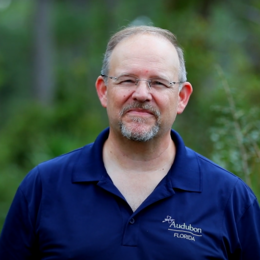Birding is fun.
Who doesn't enjoy a casual walk through a beautiful park, stopping occasionally to watch a Brown-headed Nuthatch bounce up a tree, or a Pine Warbler pluck a caterpillar from a cluster of pine needles? "Better than any day in the office," as a friend's email signature claims.
More and more birders are realizing we can't let it end there - we need to turn our passion for birding into a tool for conservation. In fact, this strategy may be necessary to keep our favorite places protected and rich with birds.
The following are suggestions for conservation birding inspired by the Audubon chapters in Northeast Florida. They can be practiced by any group or individual, and make birding more enjoyable and serve a larger purpose.
1. Create a "conservation context" for your birding trip.
Who owns the land you're birding on? Is there a management plan for the area? Does it support important populations of resident or migratory birds? These are questions that can be researched before your trip and shared with any participants. You may be birding in a park purchased with funds from an important conservation effort; this is great information to share with people enjoying these benefits. Or, perhaps your birding location is home to a rare species. A little research before your trip can provide interesting information to share about why that species is rare and what can be done to ensure its conservation.
2. Use eBird to record your birding observations.
Many birders use the eBird website and related mobile apps to better enjoy birding. It’s an easy system that helps you manage, share, and review your birding experiences – at home and in the field. The underappreciated benefit of using eBird, though, is that you are contributing to a large citizen-science effort that is frequently used to inform a variety of conservation actions.
In Northeast Florida, we recently learned another benefit of tracking our birding trips using eBird – demonstrating the frequent use of conservation lands by birders! Land managers often weigh decisions about the types of recreation that should be allowed and encouraged on their properties, and what changes can be made to improve conditions for their frequent users. It is easy for birding to be overlooked since it is a low-impact, quiet form of passive recreation. Local resource managers can review checklists submitted to eBird and better understand use of their properties (by humans and birds!).
Which brings us to our final bit of advice.
3. Build a relationship with resource managers.
We treasure the natural areas around us that support birds, other wildlife, and our outdoor recreation. Often, these lands and waters are cared for by a small number of managers that are often grateful for assistance in furthering their mission. Audubon chapters in our region started writing letters to resource managers, letting them know who we are, how often we visit, and how we use their property (e.g., birding, education, or programs). We inform them of our bird observations and offer to teach them about eBird. The response from managers has been impressive, with many asking to learn about eBird, requesting surveys to improve data, and inviting Audubon members to participate in management plan reviews.
For many, birding is more of an obsession than a hobby. It’s hard to imagine that anything could keep us from our favorite activity. By using eBird, and taking some time to learn about the sites you visit and their management, you can ensure healthy bird populations for you and future generations to enjoy.
Birding is fun. Let’s make it helpful, too.






